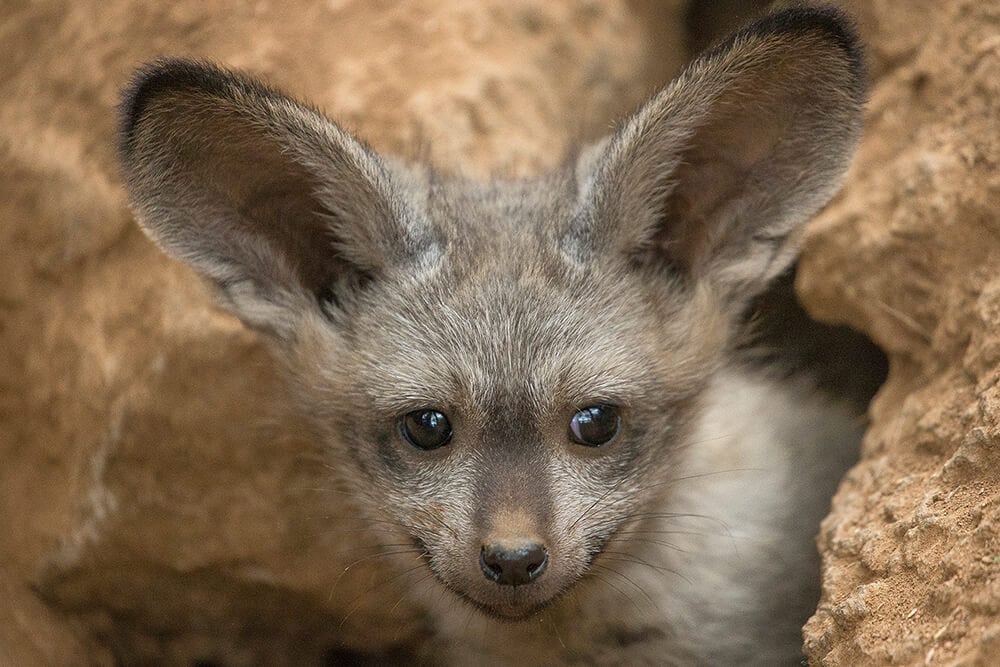The Bat-eared fox (Otocyon megalotis), a species of fox native to the African savanna, is known for its quite uncommon appearance. This mammal is easily recognized by its unusually enormous ears in proportion to its head, and its raccoon-like facial features. These exceptionally large ears are what earned this species its colloquial name Bat-eared fox.
The Bat-eared fox is the only living species of the genus Otocyon. The scientific name ‘Otocyon megalotis’ originates from the Greek words “oto/Otis” for ear, “cyon” for dog, while “mega” means big or large, therefore essentially meaning ‘eared dog with big ears’. The Bat-eared fox is categorized in two subspecies, namely the Otocyon megalotis megalotis (occurring in southern Africa) and Otocyon megalotis virgatus (found in eastern Africa).

Credit: Derek Keats, CC BY 2.0, via Wikimedia Commons
Its huge ears, measuring over 5 in (13 cm) tall, play an important role in terms of thermoregulation. Indeed, numerous blood vessels in the ears help to shed heat and maintain a cool body temperature. Bat-eared foxes are rather small, with a head-to-body length ranging from 46 to 66 cm and their tail measuring between 23 and 34 cm. They have relatively short legs and stand at a shoulder height of 30 to 40 cm and weight between 3 and 5.3 kg.

Usually, their coat is tan-colored or yellow-brown, with lighter fur on the throat and undersides. The gray agouti guard hairs around the outside of the ears create a grizzled appearance. The lower legs and feet are dark brown or black, as well as the tip of their bushy tail. Also, they have darker fur surrounding the eyes, muzzle and at the back of the ears while the inside of the ears and a band across the forehead are white or buff.

Apart from their large ears being a prominent feature, the bat-eared fox stand apart from other foxes due to their teeth – indeed, they possess more teeth (46 to 50) than most mammals. Also, compared to other canid species, these teeth are much smaller and have less shearing surface formation, making them highly adaptable to the fox’s insectivorous diet. Bat-eared foxes have three upper and four lower molars, which differentiate them from other members of the dog family, which are equipped with two upper and three lower molars on each side of the mouth.
Read Also: Beautiful Zen Foxes Are Photographed Enjoying Some Peaceful Time In The Wild

Credit: Yathin S Krishnappa via Wikimedia Commons
Among the canid family, the bat-eared fox is considered to be the only truly insectivorous. Termites comprise 70 percent of its diet, with its favorite being the harvester termites (Hodotermes mossambicus), which make up for 80–90% of its diet. An individual can consume up to 1.15 million termites each year.
However, if this specific species of termite is scarce, the fox also feeds on other arthropods such as ants, dung beetles and their larvae, grasshoppers, crickets, scorpions, millipedes, moths, spiders, and sometimes birds, birds’ eggs and chicks, small mammals, and reptiles. Occasionally, the bat-eared fox can also consume fungi (the desert truffle Kalaharituber pfeilii), berries, seeds, and wild fruits, although insects consist of the main portion of its diet. Most of their water supply is obtained from the body fluid of the insects they ingest.

Apart from playing a key role in thermoregulation, their remarkably large ears provide them with an extraordinary sense of hearing – they can listen for insects moving on the ground and thus locate their prey. Just imagine being able to hear beetles and other insects crawling around – that’s how good their sense of hearing is!

Their hunting technique mainly consists of auditory means, rather than making use of the sense of smell or sight. The fox walks slowly with its nose close to the ground and its ears tilted forward. Upon detecting its prey, the small canid jumps or digs hastily to catch them and eats them up, satisfying itself with a nice, high-protein meal.

Credit: James Hager

This is the reason why we will find bat-eared foxes waiting around hoofed mammals, as this means lots of poops from the ungulates as well as numerous insects buzzing around the animals’ droppings. Undoubtedly, that’s a rather easily available feast for the foxes! Bat-eared foxes sometimes travel up to 7.5 miles (12 km) at night in search of food.
Read Also: Meet The Tibetan Fox, A Rarely Sighted Animal With A Unique Facial Expression

As extremely social creatures, bat-eared foxes often live in pairs or groups. In southern Africa, they are usually monogamous and raise their kits in pairs, while in eastern Africa, they may live in pairs or in a stable family unit comprising a male and up to three closely related females with kits. The foxes use their claws for digging their den, or they may even enlarge an empty burrow created by another animal, for instance, old termite mounds are used as dens.

Credit: Suzi Eszterhas

Inhabiting a rather harsh environment, the den serves as a protected space for the group to sleep in and also where the females give birth and will raise the young ones. There are several den holes in the fox’s territory, consisting of various entrances, tunnels, and chambers. The den provides shelter from high temperatures and wind, as well as from their predators like eagles, hyenas, and jackals. In South Africa, the foxes may also be found lying under the shade of acacia trees during the day.

These canids are mainly nocturnal, with 85 percent of their activity happening at nightfall. In the late afternoon, they emerge from the comfort of their den to socialize and play. Within the family groups, males can be seen participating in guarding, grooming, and playing with the kits, as much as or if not even more than the mothers, thus sharing the responsibility of raising the young ones.

As nighttime approaches, the foxes leave the den site to forage for food. These mammals normally hunt in groups, often pairing up within separated subgroups advancing through the same region. Around midnight, they take a break to rest and will then go back to their search for food until dawn. Returning to their den area, bat-eared foxes socialize and just enjoy basking in the sun until it gets too hot, and they seek the shelter and comfort of their den again.

An interesting characteristic about these foxes is that their activity pattern relies on the behavior of the harvester termites. In southern Africa, the foxes are active at night during the hot summer months but are diurnal in wintertime, while in eastern Africa, they are mostly nocturnal. The fact that bat-eared foxes tend to forage, socialize, play and sleep together in a group is what helps to keep them safe from predators.

However, when they do need to escape from predators, they make use of their phenomenal agility and speed. They do so by skillfully dodging predators and have the ability to reverse directions at a flat run without affecting their momentum. Apart from their exceptional sense of hearing, the bat-ear fox can also recognize individuals up to 30 m away.
Read Also: Manja, The Rare Melanistic Serval Cat Roams The Serengeti In Tanzania

Bat-eared foxes breed annually, with the females giving birth to a litter of three to six pups, after a gestation period of 60–70 days. Fox kits are born about the size of domestic kittens and in fact, they resemble Chihuahua pups but with much larger ears!
The female hunts for food, and she needs to feed herself well to maintain milk production as the lactation period last for 10 to 15 weeks. As opposed to other canids, she rarely regurgitates solid food for her babies, as this would contain lots of hard insects’ parts that are not digested by the kits. Therefore, the pups rely heavily on milk feeding. When they are about 8 to 12 days old, the kits start to come out of the den, but sadly, it often happens that one or two of the smaller pups die in the first three weeks.


Credit: Sandiegozoo
Also, what differentiates the bat-eared foxes from other canids is that they have a reversed parental role, with the male being responsible for the most part of parental care and duties after the lactation period. The father teaches his young ones how to forage and will groom them, defend and chaperon them, and also carry them between den sites. At about 6 months old, the young foxes are fully grown, and they start to scatter around and leave their family groups. Females reach their first breeding period at about 18 months old.

Now, some interesting facts about the body language of the bat-eared fox. This species makes use of different visual displays which are essential when communicating. For instance, when they are staring intensely at something, they hold their head high, with eyes open, their mouth closed, and the ears are erect and facing forward.

If a fox is feeling threatened or is capitulating, its head is held low, and the ears are pulled back and lying against the head. As well, their tail is employed in communicating with one another. When asserting dominance or displaying aggression, or if the animal is feeling threatened, the tail is arched in an inverted U shape. This also happens when the fox is playing or is being sexually aroused. The tail is in a horizontal and straight position when the mammal is running, chasing or fleeing. Bat-eared foxes can also make themselves appear bigger when feeling alarmed, by using piloerection, which happens when each strand of hairs are upright.

With the human population growing, and new settlements and roads are constructed, along with the expansion of agricultural land, all of these pose some threats to the bat-ear fox population. Although there are no major threats to this species, they have been hunted for their fur in Botswana, and in South Africa, they are being hunted for trophies. However, they are also viewed as threats and predators of small livestock.



Credit: Sandiegozoo


Read more articles:
- Silent Killers of the Sea: Fishing Nets and the Devastating Impact on Our Oceans
- Amazing Ability of Sharks to Regrow Their Dorsal Fins
- Mountain Marvels: 7 Architectural Wonders Built into Nature’s Slopes
- The Frilled Shark: Jaws of the Abyss and a Living Fossil
- 30 Christmas Rock Painting Ideas – Last minute DIY crafts for Christmas decor, gifts and stocking fillers

